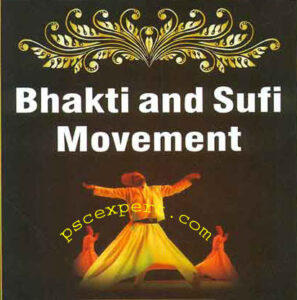BHAKTI SUFI MOVEMENT MEDIEVAL INDIA
BHAKTI SUFI MOVEMENT MEDIEVAL INDIA
- Hagiographies= Biographies of saints written by their followers (or members of their religious sect).
- The birth of bhakti movement in the Tamil country in 6th century
- Its flourished in south india for about three centuries under two wings i.e shavism & vaishnavism.
- Follower of shaivism called Nayanars and Follower of Vaishnavism is called Allwars
Characteristics of Bhakti movements
- The object of devote is to obtain “moksha”
- It emphasized on purity of mind and heart.
- Bhakti movement generally monotheistic either it is formless god(nirgun) or a god with form(sagun)
- Both are based on Upnishad
- Gyan or Knowledge is important element in Bhakti
- Bhakti movement was egalitarian movement
- Used simple laungauge
- Against superiority of priests (varn system)
Two main objective of BHAKTI SUFI MOVEMENT MEDIEVAL INDIA movement is-
- Reform in Hinduism that Hinduism should be strong in comparison with Islam.
- To propagate the Hindu Muslim friendship and unity.
Saints of bhakti movement
Ramanand
- First saint of north India in the first half of 15 century.
- He worshipper of ram and believes on two principles
- Perfect love for god
- Human brotherhood
- He had disciples of all caste and used Sanskrit and local language for preaching.
- 12 prominent disciples “Avadhuts” of Ramanand
- Kabir =weaver
- Raidas=cobbler
- Sen=Barbar
- Dhanna=Jat peasent
- Pipa=Rajput
- Bhavanand
- Asanand
- Sukhanand
- Sursuranand
- Parmanad
- Shriananad
- Mahananad
Kabir
- His follower were called Kabirpanthi
- He believes in Nirgun bhakti
- He targeted evils of both the religion Hindu and Muslim.
- He refused superiority of Brahmans and gave equal status to both Brahmans and shudras.
- He thought Hindu-Muslim unity
- The chief scripture of kabir panth is well known as Bijak.
Guru nanak
- In north India between 15th and 16th century got extraordinary successes
- He asserted that Hindu and Muslim were children of one god
- He stood for unity of Hindu Muslim and his principle was social equality.
- He wrote inspirational songs and peom that later published as “Adi Granth”
Mera bai
- Greatest lady saint of bhakti movement from Rajasthan
- After her husband death she consider Krishna as husband
- She was deeply devoted to the Krishna
- She composed poetry in Rajasthani and brij
Vallabhacharya
- He was from Krishna cults
- He wrote many books in Sanskrit and brijbhasha
- He consider pushtimarg the means to realize the god
Dadu
- He was from Gujarat spend his most of time naraina in Rajasthan
- He was cobbler by caste
- He supported Hindu-Muslim unity and opposed rigid caste system and idol worship
- His follower is know as Dadupanthi
Surdas and Tulsidas
- Surdas =Krishna cults
- Tulsidas =Ram cults
- Both in 16 th century
- Both composed poetry
Sant Gyaneshwar
- He was in Maharashtra in 13th century
- He wrote commentary on Geeta know as “Gyaneshwari” in Marathi
Namdev
- Also from Maharashtra
- Devotee of Vithobha or Vishnu
- He opposed caste system
Eknath
- He said nirvana is possible through devotion
Tukaram
- Most popular in mahashtra
- He was founder of Varkari sect
- He preached through “Abhang”
Note –All saints of Maharashtra worshiped the idol worship of Pandhurnga,Vithoba or Vishnu centralized at Pandharpur
Sufism
- Ulemas– the schoolars who thaught how to run the government in accordance with orthodox sunni ideas called ulemas
The Sufi –
- Contrary to ulemas were the Sufis
- They oppose the vulgar display of wealth in publics
- The were against the formal worship, rigidity and fanaticism in religion
- They used mediation to achieve religious satisfaction
- Sufis were divided into silsilah
- Each silsilah having guide i.e (per) or Kwaja or sheikh.
- Silsilah were divided into two types
- Ba-Shara = followed sharia
- Chisti(silsilah)
- Suhawardi
- Firdwasi
- Qadiri
- Nashbandi
Be-shara= not followed sharia
- Qalandar (silsilah)
- Among them chistis were most popular in India founded by the Kwaja Muinuddin Chisti. Ajmer was the teaching center
